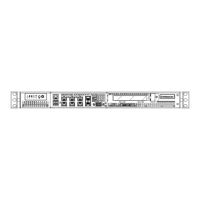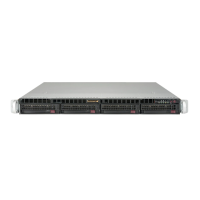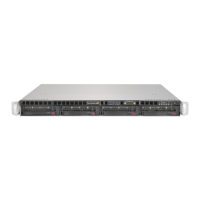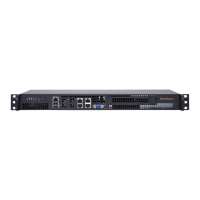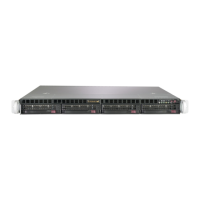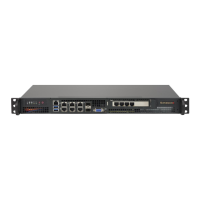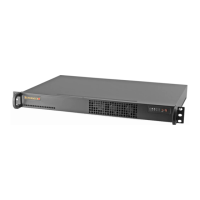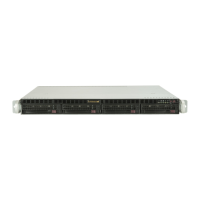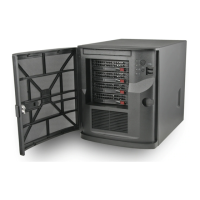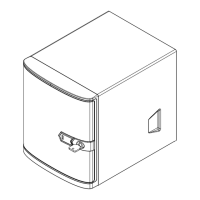Do you have a question about the Supermicro SuperServer 5019D-FN8TP and is the answer not in the manual?
Describes the manual's purpose, scope, and target audience.
Provides links to drivers, utilities, and contact information.
Explains the meaning of warning symbols used throughout the manual.
Outlines the functions and features of the SuperServer 5019D-FN8TP.
Instructions for unpacking the server and choosing a suitable location.
Details the key hardware and specification features of the system.
Describes the control panel buttons, LEDs, and front chassis components.
Illustrates the motherboard and identifies major component locations.
Provides a concise list of jumpers, LEDs, and connectors with default settings.
Introduces advice and instructions for mounting the system in a server rack.
Covers location, rack, and server precautions, including environmental and safety guidelines.
Provides step-by-step instructions for mounting the chassis into a rack unit.
Details the steps to safely disconnect power from the system.
Instructions for removing the chassis top cover to access internal components.
Covers memory installation, population, and motherboard battery replacement.
Details the installation of hard drives, expansion cards, and cooling system components.
Details the main ATX, 8-pin CPU, and HDD power connectors on the motherboard.
Describes various motherboard headers like fan, LED, and I/O connectors.
Lists and defines the connectivity ports available on the rear panel.
Explains the connectors for front panel buttons and LEDs on the motherboard.
Explains the purpose and configuration options for motherboard jumpers.
Describes the status and meaning of various system LEDs on the motherboard.
Provides steps for installing the Windows operating system and necessary drivers.
Guide for downloading and installing essential system drivers from the Supermicro website.
Details the SuperDoctor 5 utility for system health monitoring and management.
Information on using IPMI for remote access, monitoring, and management.
Introduces the AMI BIOS setup utility and how to access it during boot-up.
Describes the primary settings and information displayed in the BIOS main menu.
Covers detailed system configuration options like CPU, memory, chipset, and boot settings.
Instructions for configuring and viewing system SMBIOS event logs.
Details the configuration options for the Intelligent Platform Management Interface.
Details system security, password settings, and boot behavior configuration.
Configuration options for selecting boot mode and boot device priorities.
Procedures for saving configuration changes and exiting the BIOS setup utility.
Lists beep codes for Power-On Self-Test (POST) errors and their descriptions.
Provides information on obtaining additional BIOS POST checkpoint codes.
Explains the purpose and meaning of industry standard safety warnings.
Details the CPU and chipset used in the SuperServer system.
Information on BIOS type and supported memory configurations.
Covers SATA controller, drive bays, and PCI expansion slot capabilities.
Details the chassis dimensions, form factor, and system cooling fan specifications.
Details power supply specifications and system operating temperature/humidity limits.
Lists electromagnetic emissions, immunity, and safety compliance standards.
Explains the Unified Extensible Firmware Interface (UEFI) and its role in recovery.
Describes the UEFI BIOS structure and the process for recovering a corrupted image.
Provides steps to recover the BIOS using a USB flash device without extra utilities.
Introduces the Dual Boot Block feature for BIOS boot block recovery.
Explains the function and importance of the BIOS boot block.
Describes common causes of BIOS boot block corruption during updates.
Details the procedure for rebooting the system using the JBR1 jumper.
| Processor model | D-2146NT |
|---|---|
| Processor socket | - |
| Built-in processor | Yes |
| Number of processors supported | 1 |
| Memory voltage | 1.2 V |
| Number of DIMM slots | 4 |
| Supported memory types | DDR4-SDRAM |
| Maximum internal memory | 512 GB |
| Supported RDIMM clock speeds | 2133, 2400, 2666 MHz |
| Supported DIMM module capacities | 16GB, 32GB, 64GB, 128MB |
| Storage drive sizes supported | 2.5 \ |
| Supported storage drive types | HDD & SSD |
| Supported storage drive interfaces | Serial ATA III |
| LAN controller | Intel I350-AM4, Intel X557 |
| Ethernet LAN data rates | 10, 100, 1000, 10000 Mbit/s |
| Ethernet interface type | 10 Gigabit Ethernet, Fast Ethernet, Gigabit Ethernet |
| Copper ethernet cabling technology | 10BASE-T, 100BASE-TX, 1000BASE-T |
| Chassis type | Rack (1U) |
| Fan diameter | 40 mm |
| Product color | Black |
| LED indicators | HDD, LAN, Power, Status, Temperature |
| Number of fans | 3 fan(s) |
| USB 2.0 ports quantity | USB 2.0 ports have a data transmission speed of 480 Mbps, and are backwards compatible with USB 1.1 ports. You can connect all kinds of peripheral devices to them. |
| Ethernet LAN (RJ-45) ports | 6 |
| USB 3.2 Gen 1 (3.1 Gen 1) Type-A ports quantity | 2 |
| Trusted Platform Module (TPM) version | 2.0 |
| Package depth | 465 mm |
| Package width | 655 mm |
| Package height | 155 mm |
| Package weight | 5440 g |
| Power supply | 200 W |
| AC input voltage | 100 - 240 V |
| AC input frequency | 50 - 60 Hz |
| 80 PLUS certification | 80 PLUS Gold |
| DC output current (+5 V) | 8 A |
| DC output current (+12 V) | 16 A |
| Sustainability certificates | RoHS |
| BIOS type | AMI |
| ACPI version | 5.0 |
| UEFI version | 2.4 |
| BIOS memory size | 128 Mbit |
| System Management BIOS (SMBIOS) version | 2.8 |
| Storage temperature (T-T) | -40 - 70 °C |
| Operating temperature (T-T) | 0 - 40 °C |
| Storage relative humidity (H-H) | 5 - 95 % |
| Operating relative humidity (H-H) | 8 - 90 % |
| Harmonized System (HS) code | 84714100 |
| Depth | 249 mm |
|---|---|
| Width | 437 mm |
| Height | 43 mm |
| Weight | 3630 g |
